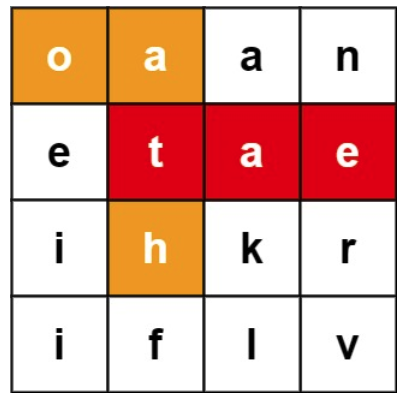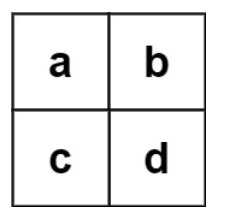Problem Statement
Given an m x n board of characters and a list of strings words, return all words on the board.
Each word must be constructed from letters of sequentially adjacent cells, where adjacent cells are horizontally or vertically neighboring. The same letter cell may not be used more than once in a word.
Examples
Example 1

Input:
board = [[“o”,”a”,”a”,”n”],[“e”,”t”,”a”,”e”],[“i”,”h”,”k”,”r”],[“i”,”f”,”l”,”v”]],
words = [“oath”,”pea”,”eat”,”rain”]
Output: [“eat”,”oath”]
Example 2

Input:
board = [[“a”,”b”],[“c”,”d”]],
words = [“abcb”]
Output: []
Constraints
m == board.length
n == board[i].length
1 <= m, n <= 12
board[i][j] is a lowercase English letter.
1 <= words.length <= 3 * 104
1 <= words[i].length <= 10
words[i] consists of lowercase English letters.
All the strings of words are unique.
Solution
class TrieNode:
"""
prefix tree for words
"""
def __init__(self):
self.children = {}
self.isWord = False
def addWord(self, word):
curr = self # root of the Tree
for char in word:
if char not in curr.children: # if current character not in children dictionary keys
curr.children[char] = TrieNode() # add a trie node
curr = curr.children[char] # grab the key
# after adding all character, make the leaf node as end of a complete word
curr.isWord = True
class Solution:
def findWords(self, board: List[List[str]], words: List[str]) -> List[str]:
# initialize the problem space
ROWS = len(board)
COLS = len(board[0])
# additional memory to keep track of visited word
result = set()
visited = set()
# root of the prefix tree which will have all the words
root = TrieNode()
# build the prefix tree
for word in words:
root.addWord(word)
def dfs(r, c, node, word):
# base case
if (r < 0 or c < 0 or r == ROWS or c == COLS) \
or (r, c) in visited \
or board[r][c] not in node.children:
return
visited.add((r, c))
word += board[r][c]
node = node.children[board[r][c]] # get the key
if node.isWord: # if we find a full word, add it to result
result.add(word)
# otherwise traverse
dfs(r + 1, c, node, word)
dfs(r - 1, c, node, word)
dfs(r, c + 1, node, word)
dfs(r, c - 1, node, word)
visited.remove((r, c)) # remove from visited to allow backtracking
# traverse each item from the character board
for r in range(ROWS):
for c in range(COLS):
dfs(r, c, root, "")
return list(result)
Complexity Analysis
Time Comlexity
Brute Force Approach
For each word, traverse the board and return true if that word exist in the board
Time for each DFS: Traverse in four direction for each Depth First Search (dfs). In worst case, we need to traverse until the length of the word. So, one dfs will have 4*3^(L-1) where L is the length of a word
Time to Search one Word in the Board: In worst case, the first character of the word we are searching can be situated on board[m - 1][n - 1] index. So, for worst case we need to go (complexity to find the first character in the board) * _(complexity for one word search) = m * n * 4 * 3^(L-1)
Operation #2 happens for each word search. So, total complexity is (number of word search) * (complexity for one word search) = O(W * m * n * 4 * 3^(L-1))
Prefix Trie Approach
Prefix Trie removes the need to search the complete board for each word again and again, instead we will build a prefix tree one time and search the board one time only and grab all the word which exist in the board
Time to Add input words in Trie Data Structure: For each word it will take O(logL), where L is the longest word length. So, for all input words, O(W * logL)
Time for each DFS: Traverse in four direction for each Depth First Search (dfs). In worst case, we need to traverse until the length of the word. So, one dfs will have 4 * 3^(L-1) where L is the length of a word
Traverse the complete board: For worst case we need to traverse the full board if input has words which first characters are a complete set of board’s character. So, for worst case we need to go (complexity to traverse the full board) * (complexity for one word search) = m * n * 4 * 3^(L-1)
So, Overall complexity is
= (complexity to add word in trie) + (complexity to traverse the full board) * (complexity for one word search)
= O(W * logL) + O(m * n * 4 * 3^(L-1))
= O(m * n * 4 * 3^(L-1))
This is a huge improvement if we have large input of words need to search
Space Complexity
Brute Force Approach
Overall space complexity is
= (visited set) + (dfs call stack)
= O(n) + O(logL)
= O(n)
Prefix Trie Approach
Main comlexity in this problem is to build the prefix tree. It will have space complexity of all the characters from words input. In worst case, fully formed prefix tree can have 26 children and 26 branches as the input can be only english lowercase letters. O(26 * 26) ~ O(1)
For dfs we are using one additional visited set. O(n)
For dfs/backtracking, we will have call stack space in memory. It can be as long as length of the trie. O(logL)
So, Overall space complexity is
= (complexity to build prefix tree) + (visited set) + (dfs call stack)
= O(1) + O(n) + O(logL)
= O(n)
Areas To Optimize
- Input words can have duplicate items, in that case dfs algorithm will traverse same path multiple times. In that case, after we visited one word, we can remove that path from the prefix tree to avoid multiple traversing.
